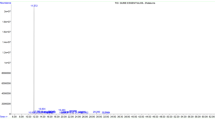Abstract
6-Methoxydihydrosanguinarine (6ME), a benzophenanthridine alkaloid derived from the methanol extracts ofHylomecon hylomeconoides, showed a dose-dependent effect at 1–10 μM on causing apoptotic cell death in HT29 colon carcinoma cells (IC50 = 5.0 ± 0.2 μM). Treatment of HT-29 cells with 6ME resulted in the formation of internucleosomal DNA fragmentation. Treatment of the cells with 6ME caused activation of caspase-3, -8 and 9 protease and subsequent proteolytic cleavage of poly(ADP-ribose)polymerase. 6ME increased the expression of p53 and Bax and decreased the expression of Bid. These results indicate that p53 and proapoptotic Bcl-2 family proteins might participate in the antiproliferative activity of 6ME in HT29 cells.
Similar content being viewed by others
References
Chen, J. J., Chang, Y. L., Teng, C. M., Lin, W. Y, Chen, Y. C., and Chen, I. S., A new tetrahydroprotoberberineN-oxide alkaloid and anti-platelet aggregation constituents of Corydalis tashiroi.Plants Med., 67, 423–427 (2001).
Cho, Y. S., Phytochemical constituents of Hylomecon hylomeconoides and their activities on neurotransmitter-metabolizing enzymes. Thesis: Chungnam National University (2001).
Devitt, G. P., Creagh, E. M., and Gotter, T. G., The antioxidant 4b, 5, 9b, 10-tetrahydroindeno[1,2-b]indole inhibits apoptosis by preventing caspase activation following mitochondrial depolarization.Biochem. Biophys. Res. Comm., 264, 622–629 (1999).
Giardiello, F. M., Hamilton, S. R., Krush, A. J., Piantadosi, S., Hylind, L. M., Celano, P., Booker, S. V., Robinson, C. R., and Offerhaus, G. J., Treatment of colonic and rectal adenomas with sulindac in familial adenomatous polyposis.N. Engl. J. Med., 328, 1313–1316 (1993).
Greenlee, R. T., Murray, T., Bolden, S., and Wingo, P. A., Cancer statistics, 2000.CA Cancer J. Clin., 50, 7–33 (2000).
Herr, I. and Debatin, K. M., Cellular stress response and apoptosis in cancer therapy.Blood, 98, 2603–2614 (2001).
Janicke, R. U., Sprengart, M. L., Wati, M. R., and Porter, A. G., Caspase-3 is required for DNA fragmentation and morphological changes associated with apoptosis.J. Biol. Chem., 273, 9357–9360 (1998).
Juo, P., Kuo, C. J., Yuan, J., and Blenis, J., Essential requirement for caspase-8/FLICE in the initiation of the Fas-induced apoptotic cascade.Curr. Biol., 8, 1001–1008 (1998).
Kischkel, F. C., Hellbardt, S., Behrmann, I., Germer, M., Pawlita, M., Krammer, P. H., and Peter, M. E., Cytotoxicity-dependent APO-1 (Fas/CD95)-associated proteins form a deathinducing signaling complex (DISC) with the receptor.EMBO J., 14, 5579–5588 (1995).
Korsmeyer, S. J., Wei, M. C., Saito, M., Weiler, S., Oh, J., and Schlesinger, P. H., Pro-apoptotic cascade activates BID, which oligomerizes BAK or BAX into pores that result in the release of cytochrome c.Cell. Death. Differ., 7, 1166–1173 (2000).
Lowe, S. W., Ruley, H. E., Jacks, T., and Housman, D. E., p53-dependent apoptosis modulates the cytotoxicity of anticancer agents.Cell, 74, 957–967 (1993).
Monks, A., Scudiero, D., Skehan, P., Shoemaker, R., Paull, K., Vistica, D., Hose, C., Langley, J., Cronise, P., Vaigro-Wolff, A., Gray-Goodrich, M., Campbell, H., Mayo, J., and Boyd, M., Feasibility of a high-flux anticancer drug screen using a diverse panel of cultured human tumor cell lines.J. Natl. Cancer Inst., 83, 757–766 (1991).
Muzio, M., Chinnaiyan, A. M., Kischkel, F. C., ORourke, K., Shevchenko, A., Ni, J., Scaffidi, C., Bretz, J. D., Zhang, M., Gentz, R., Mann, M., Krammer, P. H., Peter, M. E., and Dixit, V. M., FLICE, a novel FADD-homologous ICE/CED-3-like protease, is recruited to the CD95 (Fas/APO-1) deathinducing signaling complex.Cell, 85, 817–827 (1996).
Steinbach, G., Lynch, P. M., Phillips, R. K., Wallace, M. H., Hawk, E., Gordon, G. B., Wakabayashi, N., Saunders, B., Shen, Y., Fujimura, T., Su, L. K., and Levin, B., The effect of celecoxib, a cyclooxygenase-2 inhibitor, in familial adenomatous polyposis.N. Engl. J. Med., 342, 1946–1952 (2000).
Author information
Authors and Affiliations
Corresponding author
Rights and permissions
About this article
Cite this article
Lee, YJ., Yin, HQ., Kim, YH. et al. Apoptosis inducing effects of 6-Methoxydihydrosanguinarine in HT29 colon carcinoma cells. Arch Pharm Res 27, 1253–1257 (2004). https://doi.org/10.1007/BF02975890
Received:
Issue Date:
DOI: https://doi.org/10.1007/BF02975890




